#label and tags manufacturer
Text
#synthetic paper for tags#synthetic paper for labels#non tearable tags#water proof tags#label and tags manufacturer#tags supplier
0 notes
Text

#Great Dane#year round coat#cosmopolitan manufacturing co#vintage Boston#vintage label#vintage tag#vintage design#vintage font#1950s#1960s
5 notes
·
View notes
Text
Enhancing Brand Identity with Seal String Tags: A Stylish Statement in Packaging
From the choice of colors to the texture of materials, each element plays a crucial role in conveying a brand's identity and message. In this landscape, seal string tags emerge as not just a functional addition but also as a stylish statement that elevates the packaging experience.
Seal string tags, also known as hang tags, are small accessories attached to products via a string or cord. Traditionally used for labeling and providing essential information about the product, they have evolved into a powerful branding tool that communicates a brand's values and personality. At Golden Fabtex, we understand the significance of these tags in creating lasting impressions, and we offer a range of options to cater to diverse branding needs.
First and foremost, seal string tags serve a practical purpose. They provide essential information such as product name, price, size, and care instructions, offering customers valuable insights at a glance. Moreover, they can include barcodes or QR codes for easy inventory management and seamless checkout processes. By incorporating these tags into packaging, brands ensure that their products are not only visually appealing but also informative and user-friendly.
However, beyond their functional utility, seal string tags serve as a unique canvas for branding and storytelling. With customizable designs, shapes, and materials, brands can unleash their creativity and craft tags that reflect their identity. Whether it's a minimalist design with a subtle logo embossed on recycled paper or a vibrant tag adorned with intricate illustrations, each tag conveys a brand's aesthetic and values.
Furthermore, seal string tags offer an opportunity for brands to engage with their audience on a deeper level. By sharing compelling narratives, brand ethos, or sustainability initiatives on these tags, brands establish meaningful connections with consumers. In an era where conscious consumerism is on the rise, such transparency and authenticity resonate with customers and foster brand loyalty.
Additionally, seal string tags can serve as a powerful marketing tool, extending beyond the point of purchase. When designed thoughtfully, they become keepsakes that customers are reluctant to discard. Whether pinned on a mood board, repurposed as bookmarks, or used as decorative elements, these tags continue to promote brand visibility long after the initial transaction.
At Golden Fabtex, we recognize the importance of seal string tags in shaping brand identity and enhancing the unboxing experience. That's why we offer a wide range of customization options, including choice of materials, printing techniques, and finishing touches. Whether you're a small boutique seeking to differentiate your products or a global brand aiming to make a statement, our team is committed to bringing your vision to life.
Brand Storytelling
In an era where consumers crave authenticity and connection, seal string tags serve as a canvas for brand storytelling. Beyond conveying essential product information, these tags offer an opportunity to communicate the brand's narrative, values, and ethos.
For example, a heritage brand with a rich history could use its tags to share anecdotes and milestones, fostering a sense of nostalgia and authenticity. Alternatively, a socially responsible brand committed to sustainability could highlight its eco-friendly practices and initiatives, resonating with environmentally conscious consumers.
Interactive and Engaging
Seal string tags have a unique ability to engage customers on a tactile and interactive level, enhancing the overall unboxing experience. Whether it's the satisfying feeling of tearing open a perforated tag or the joy of unraveling a delicate string, these small gestures create moments of delight and anticipation.
Moreover, brands can leverage QR codes or augmented reality technology on their tags to provide interactive content, such as product tutorials, behind-the-scenes footage, or exclusive offers. By incorporating these elements, brands transform passive packaging into an immersive brand experience, fostering deeper connections with customers.
Seal string tags are more than just labels; they are powerful branding tools that leave a lasting impression on customers. By combining functionality with creativity, these tags become ambassadors of brand identity, storytelling, and sustainability. At Golden Fabtex, we invite brands to explore the endless possibilities of seal string tags and discover how they can elevate their packaging experience.
0 notes
Text
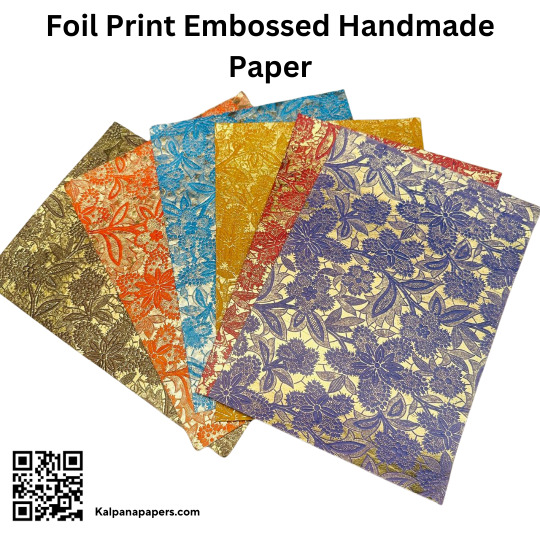
Elevate Your Brand with Exquisite Foil Print Handmade Paper: Unveiling the Artistry of Foil Printing
#Foil print handmade paper#foil print paper manufacturer#foil print paper wholesaler#foil print paper in bulk#foil print#gold foil business cards#metallic business cards#gold foil printing#foil printing co#custom foil labels#gold leaf business cards#foil printing near me#rose gold foil business cards#hot foil stamping#holographic foil printing#gold foil invitation printing#gold foil sticker printing#custom gold foil printing#square foil business cards#foil embossing near me#foil gold printing#foil hang tag printing#foil hot print#foil imprinting#foil labels custom printed#kalpana handmade papers
0 notes
Text

How can one locate apparel manufacturers for private label clothing when launching a new branded line?
To find apparel manufacturers for private label clothing, start by researching online platforms such as Alibaba, Thomas Net, or Maker's Row.
#sublimation manufacturer#sublimation clothing tags#sublimation printed labels#private label jeans#sublimation manufacturers usa
0 notes
Text
Precision in Every Tag: Unveiling Top RFID Tag Manufacturer
Find seamless tracking solutions with our cutting-edge RFID tags! As a leading RFID tag manufacturer, we redefine precision and reliability. Our state-of-the-art technology ensures each tag meets the highest standards, making us the go-to choice for industries worldwide. Elevate your tracking experience with our innovative RFID solutions that guarantee accuracy at every step.

#rfid tag manufacturer near me#nfc label near me#rfid laundry tag#UHF rfid tag near me#NFC social sharing tag
0 notes
Text
How To Select A Great Design For Custom Sign Printing

People identify designs and colors that represent a brand. For example, the red bulls-eye logo used for Target is famous, and consumers know what to look for when driving. Eye-catching signage draws people in, and then your products do their job of selling. Knowing the most important aspects of custom sign printing is essential to marketing and advertising your business.
0 notes
Text
wishing every member of the disney-mcu marketing team a very happy screaming crying throwing up as they learn that despite every algorithmically targeted test audience development by market analysis megahit they attempt to manufacture, tumblr will collectively decide without forethought or discussion that the new fandom obsession is a non-existent scorsese film premised entirely on the tag label on a pair of knock off boots
26K notes
·
View notes
Text
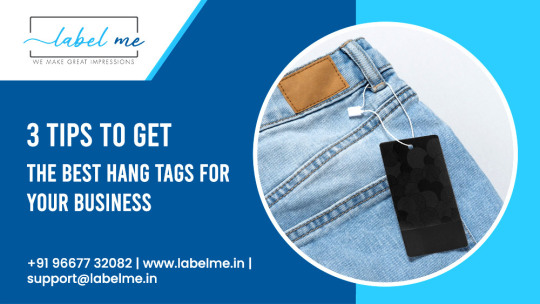
LabelMe is one of leading hang tag supplier & manufacturers in Delhi, India. We have hang tags for apparel, bags, or something else entirely. For any query call us +91 96677 32082.
#Hang Tag Supplier#Clothing Hang Tags#Hang Tag Manufacturers#Custom Label Printing#Woven label manufacture#Woven Logo Labels#Woven Clothing Labels#Custom Woven Clothing Labels
1 note
·
View note
Text
The Evolution of Apparel Tags: From Functionality to Fashion Statement
In the fashion industry, subtle details often carry the weight of a brand's identity, a narrative meticulously crafted and woven into every thread and trim. This narrative has evolved over time, with apparel labels and tags transitioning from mere fabric identifiers to paramount brand storytellers. Golden Fabtex stands at the forefront of this transformation, embodying the intersection of heritage craftsmanship and contemporary branding necessities. This examination of the tag's journey reflects not just a change in utility, but a deeper cultural shift in the realm of fashion branding.
The Inception of Identification
The story begins with a simple yet crucial function: identification. Initially, clothing tags served the basic need to convey information about garment size, composition, and care instructions. These tags were inconspicuous, tucked away out of sight, their purpose purely informational. But as the fashion landscape burgeoned, these tags started gaining prominence. No longer just a source of data, the humble tag began to whisper the first notes of a brand's legacy.
Industry expertise suggests that as brands recognized the power of recognition, tags underwent a metamorphosis in both design and placement. The evolution was gradual, a dance between functionality and emerging marketing strategies. The language of labels became more elaborate, and materials more varied, as brands sought to distinguish their products in an increasingly crowded marketplace.
A Canvas for Creativity
With the rise of fashion as a form of self-expression, tags transcended their traditional roles. They became canvases for creativity, reflecting the ethos of the brands they adorned. It was no longer just about the information; it was about the impression. Designers and brands started experimenting with colours, textures, and techniques to ensure that the tag stood out as a distinct piece of the fashion puzzle.
Expert designers and label manufacturers, with years of experience, played a pivotal role in this creative revolution. They partnered with fashion houses to develop unique tags that aligned with the aesthetic and values of the brand. It was an artistic collaboration that pushed the boundaries of what tags could represent, turning them into miniature billboards of brand identity.
Authority in Authorship
As tags gained visibility, they also gained authority. They began to tell a story, not just of the garment, but of the craftsmanship behind it. A well-designed tag could convey luxury, sustainability, or innovation, acting as a seal of authoritativeness. In this, the concept of brand image solidified, with consumers beginning to recognize and seek out the tags themselves, sometimes even dictating purchase decisions.
The shift towards authoritative branding has been supported by extensive industry expertise. Brands with a customer-focused approach, like Golden Fabtex, know that a label can be a powerful touchpoint, a direct communication line with the consumer. The tag became a pledge of quality and a promise of performance.
The Emblem of Experience
Experience, both of the brand and the consumer, began to take centre stage. Tags evolved to become emblems of a shared journey between the brand and its clientele. For instance, a tag indicating a garment's origin or artisanal method became a story of experience, a narrative that customers could participate in and wear with pride.
This experiential aspect of tags is a result of brands listening to their audience, understanding their desires, and reflecting them in every aspect of the product, including the tag. It became clear that a tag could be as personal as the garment itself, making the experience of buying and wearing fashion deeply personal and communal in equal measure.
Finally, trust became an essential part of the tag’s narrative. In a world increasingly conscious of ethical production and authenticity, tags began to carry the weight of transparency. They reassured customers of the legitimacy and ethical standing of the brand. This trustworthiness was not just implied but explicitly stated through certifications and symbols of sustainable practices.
0 notes
Text
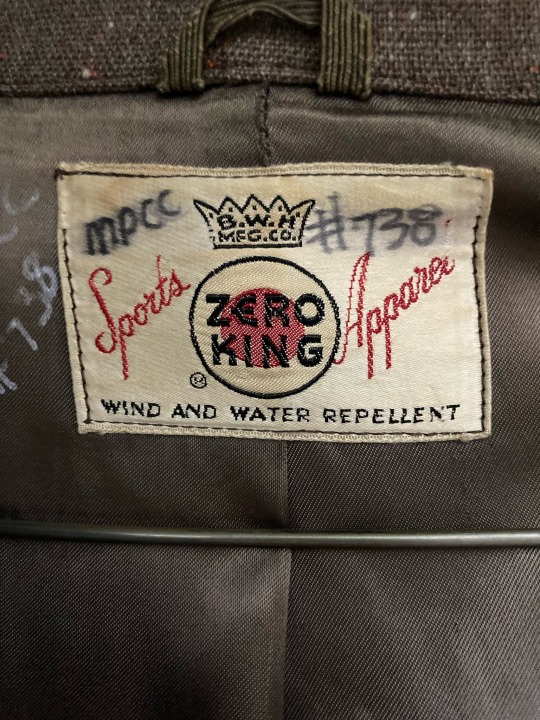
#sports apparel#zero king#b.w.h. mfg. co#b.w.g. manufacturing co#wind and water repellent#zero king sports apparel#vintage tag#vintage label#deco design#1940s
0 notes
Text
Elevate Your Brand with Exquisite Foil Print Handmade Paper: Unveiling the Artistry of Foil Printing
#Foil print handmade paper#foil print paper manufacturer#foil print paper wholesaler#foil print paper in bulk#foil print#gold foil business cards#metallic business cards#gold foil printing#foil printing co#custom foil labels#gold leaf business cards#foil printing near me#rose gold foil business cards#hot foil stamping#holographic foil printing#gold foil invitation printing#gold foil sticker printing#custom gold foil printing#square foil business cards#foil embossing near me#foil gold printing#foil hang tag printing#foil hot print#foil imprinting#foil labels custom printed#kalpana handmade papers
0 notes
Text
"Clothing tags, travel cards, hotel room key cards, parcel labels … a whole host of components in supply chains of everything from cars to clothes. What do they have in common? RFID tags.
Every RFID (Radio Frequency Identification) tag contains a microchip and a tiny metal strip of an antenna. A cool 18bn of these are made – and disposed of – each year. And with demands for product traceability increasing, ironically in part because of concerns for the social and environmental health of the supply chain, that’s set to soar.
And guess where most of these tags end up? Yup, landfill – adding to the burgeoning volumes of e-waste polluting our soils, rivers and skies. It’s a sorry tale, but it’s one in which two young graduates of Imperial College London and Royal College of Art are putting a great big green twist. Under the name of PulpaTronics, Chloe So and Barna Soma Biro reckon they’ve hit on a beguilingly simple sounding solution: make the tags out of paper. No plastic, no chips, no metal strips. Just paper, pure and … simple … ? Well, not quite, as we shall see.
The apparent simplicity is achieved by some pretty cutting-edge technical innovation, aimed at stripping away both the metal antennae and the chips. If you can get rid of those, as Biro explains, you solve the e-waste problem at a stroke. But getting rid of things isn’t the typical approach to technical solutions, he adds. “I read a paper in Nature that set out how humans have a bias for solving problems through addition – by adding something new, rather than removing complexity, even if that’s the best approach.”
And adding stuff to a world already stuffed, as it were, can create more problems than it solves. “So that became one of the guiding principles of PulpaTronics”, he says: stripping things down “to the bare minimum, where they are still functional, but have as low an environmental impact as possible”.
...how did they achieve this magical simplification? The answer lies in lasers: these turn the paper into a conductive material, Biro explains, printing a pattern on the surface that can be ‘read’ by a scanner, rather like a QR code. It sounds like frontier technology, but it works, and PulpaTronics have patents pending to protect it.
The resulting tag comes in two forms: in one, there is still a microchip, so that it can be read by existing scanners of the sort common within retailers, for example. The more advanced version does away with the chip altogether. This will need a different kind of scanner, currently in development, which PulpaTronics envisages issuing licences for others to manufacture.
Crucially, the cost of both versions is significantly cheaper than existing RFID kit – making this a highly viable proposition. Then there are the carbon savings: up to 70% for the chipless version – so a no-brainer from a sustainability viewpoint too. All the same, industry interest was slow to start with but when PulpaTronics won a coveted Dezeen magazine award in late 2023, it snowballed, says So. Big brands such as UPS, DHL, Marks & Spencer and Decathlon came calling. “We were just bombarded.” Brands were fascinated by the innovation, she says, but even more by the price point, “because, like any business, they knew that green products can’t come with a premium”."
-via Positive.News, April 29, 2024
--
Note: I know it's still in the very early stages, but this is such a relief to see in the context of the environmental and human rights catastrophes associated with lithium mining and mining for rare earth metals, and the way that EVs and other green infrastructure are massively increasing the demand for those materials.
I'll take a future with paper-based, more humane alternatives for sure! Fingers crossed this keeps developing and develops well (and quickly).
#I do really wish it could be read by regular scanners already though#that's what I thought at first#and that would've been fucking amazing#but this is still pretty cool#electronics#science and technology#green technology#ewaste#landfill#lithium#lithium mining#human rights#environment#climate action#climate hope#rfid#rfid technology#rfid tags#good news#hope
390 notes
·
View notes
Text
Top RFID Card Manufacturer for Seamless Access Solutions
Discover unparalleled access control with our RFID card manufacturing expertise. As a leading RFID card manufacturer, we prioritize quality and security. Our cutting-edge technology ensures reliable RFID cards, making us the go-to choice for secure access solutions. Choose us for durable and efficient RFID cards that redefine access control standards. Elevate your security measures with our precision-engineered RFID cards. Experience the future of access control – choose the trusted RFID card manufacturer. Your security, our priority.
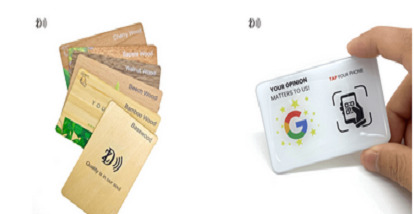
#rfid card manufacturer near me#nfc label#rfid laundry tag near me#anti metal nfc sticker#rfid textile management near
0 notes
Text
Serial Number Plates and Nameplates for Industry
If you want to give life to the serial number plates and tags, you should develop them from strong materials. In the stores, you will find a wide variety of serial number plates and tags made of materials like steel, aluminum, brass, copper, and more. In case, you wish to develop tailored nameplates or tags for your industrial machines, you may contact “Machine Plates Online” [ machineplatesonline.com ] , which is one of the reputed nameplates and tags manufacturers in the United States.
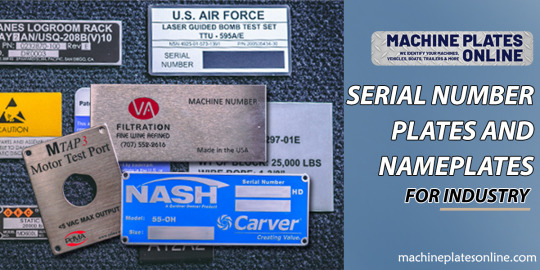
REFERENCE URL: https://bit.ly/3byNlm2
#serial number plates#metal id plates#metal serial number tags#serial number plate#aluminum serial number tags#name plate manufacturers#phenolic label maker#label engravers#legend plates
0 notes
Link
Wax, wax/resin, and resin are three different types of ribbons. The three barcode printing materials you choose will depend on the material you are using. Here is a list of some common labels and the appropriate ribbons for them.
Indoor Asset Labels: Depending on the type of environment you are using your indoor asset labels (Office Storage Area vs. Indoor Warehouse), you may choose to use paper or polypropylene label media. In that case, your labels should be made of wax (for paper) or wax/resin ribbon (for polypropylene).
Outdoor asset labels: Outdoor asset labels require a strong, durable medium that is water or humidity resistant, semi-permanent or permanent, and chemically resistant. A polyester medium with a resin ribbon will ensure that your labels last longer in harsh environments.
Product labels: Most product labels found on canned goods, bottles, plastic, and paper or cardboard packaging are printed on a simple, low-cost paper medium. To keep costs down, print on these types of labels with a wax ribbon.
Product or Inventory Tags: Unlike labels, tags do not have a sticky base so they can be applied to a product or shelf. Instead, they are attached to a product, such as a clothing tag. They can be easily removed depending on how safe they are. Tags (such as clothing tags) that are removed after a sale are usually printed on a paper label, so stick to the wax ribbon. Inventory tags are printed on more durable materials such as polypropylene and should be attached with wax/resin ribbon.
#Barcode solution#Barcode solution provider#Barcode solution provider in india#Tag manufacturer#Sticker manufacturer#Label manufacturer#Thermal transfer ribbon manufacturer
0 notes